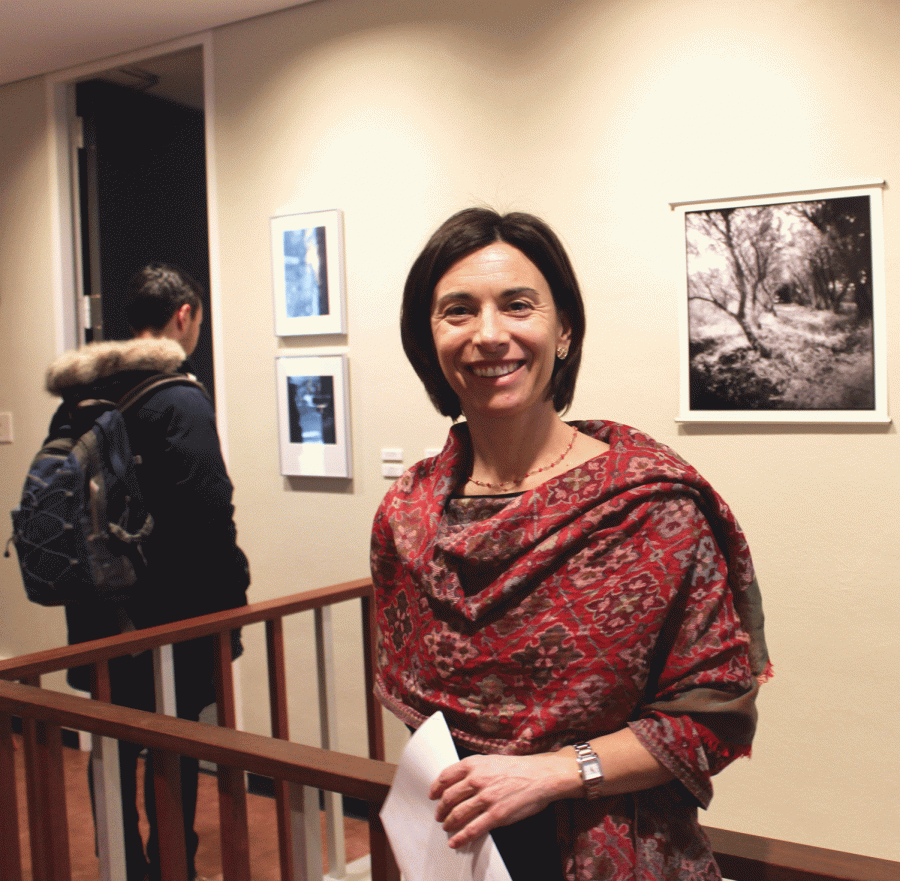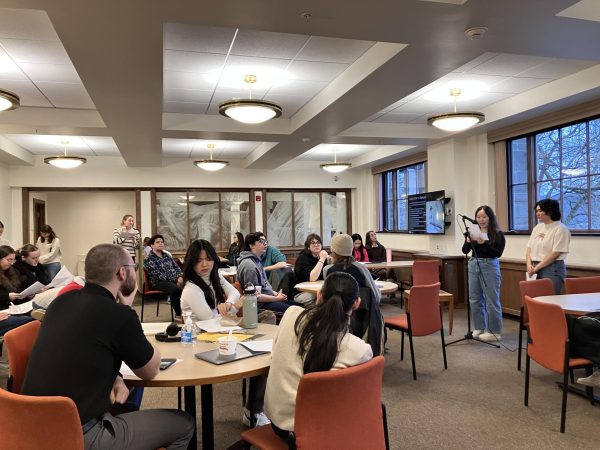An Evening of Artistry: Photography Exhibit and String Quartet Impress
Tiziana Rozzo discusses the role of cultural identity in her photography with those who visit her exhibit.
Colgate University hosted a mesmerizing performance by the Ensemble Chamarré of Olivier Messiaen’s “Quartet For the End of Time” at Chapel House on April 9. The Ensemble Chamarré has performed worldwide and has gained fame and praise for its brilliant playing and delicacy with attention to the music. Three of the players of Ensemble Chamarré frequently perform with the Boston Symphony Orchestra as well as with other leading ensembles throughout New England.
The Ensemble Chamarré is dedicated to fulfilling the powerful and moving “Quatuor Pour La Fin Du Temps,” as this is the only piece that this ensemble performs. This performance featured Catherine Hudgins on clarinet, Katie Wolfe on violin, William Rounds on cello and Vytas J. Baksys on piano. This piece, composed by Messiaen in 1940, was written in a prisoner of war (POW) camp during the excruciatingly difficult times of World War II. Messiaen cites many of his influences from his experiences as a POW as contributions to his work, including his devout Christian faith, his heightened sensory perception and colorful dreams due to starvation, his experiences witnessing the aurora borealis and his love of birdsong. The unique ensemble is composed of a piano, violin, cello and a clarinet, because these were the only instruments available to the prisoners in the camp when Messiaen was composing his piece. The first performance of “Quatuor Pour La Fin Du Temps” was in the winter of 1941 in front of hundreds of prisoners and guards in the POW camp; the Ensemble Chamarré seeks to emulate the emotions and horrific conditions through the transcending power of music. Listeners in the audience experienced the context of Messiaen’s struggles and triumphs as it relates to his composition and sought inspiration from his musical and spiritual journey of redemption in the face of despair.
Following the Ensemble Chamarré’s performance of the “Quatuor Pour La Fin du Temps” was the opening of Tiziana Rozzo’s “The Eternity of Time” photography exhibit. Rozzo is a fine art photographer based in Boston who visually investigates the connection between identity and cultural history. She believes in the power that photography has not only to tell a story, but also as a means of observation, self-reflection and emotional expression. Her photography exhibit is inspired by Messiaen’s relationship with time; she aims to create a space within her images that reinvents the experience of active silence in music, as well as in the natural world.
Rozzo says of her exhibit, “It is known that in music the measures of silence are not waiting periods. These pauses of sound can be found in photographs as well and they arouse in the viewer a state of active listening, much like a good conversation.”
Similar to Messiaen, Rozzo believes in the power of our imaginations to transform a vision and bring new depths and layers of perception into play. This exhibit in Chapel House includes mostly black and white images, allowing the viewer to fill her photographs with their own mind’s colors, encouraging active engagement and participation in the creation of a photographic memory. Rozzo’s hope is that the public will approach her photographs with enhanced senses after listening to Messiaen’s composition, further transforming the gallery into a community space for sharing ideas and cultivating collective and personal memories.
Rosso explained how this photography exhibit connects her to Colgate and why this show is unique, “The architecture of the Chapel House provides its visitors with a sense of isolation and separation from the outside world. People can come to Chapel House and reset. The large windows invite nature inside to have a conversation with the viewers of Chapel House, as my exhibit allows nature to come even further into this space. My images coupled with Messiaen’s music alongside the nature and isolationism of Chapel House provide for a thought-provoking experience of self reflection and memory construction,” Rosso said.
Contact Caylea Barone at [email protected].
Caylea Barone is a senior from LaGrangeville, New York concentrating in environmental studies and art and art history with an emphasis in studio art. She...







